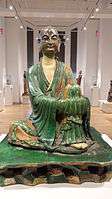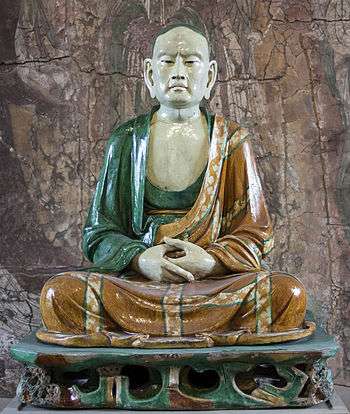Seated Luohan from Yixian
|
The statue of the seated luohan on display at the British Museum | |
| Material | Glazed stoneware |
|---|---|
| Size | 103 cm |
| Weight | 120kg (figure), 106 kg (base) |
| Created | 907-1125 AD |
| Present location | British Museum, London |
| Registration | OA 1913.1221.1 |
Discovery
This ceramic sculpture probably belonged to a set of sixteen or eighteen statues that was placed in one of the Yizhou caves that are located to the west of Yixian in the province of Hebei. They were discovered in 1912 and quickly entered the international art market. Only eight statues survive from the original set and are currently dispersed amongst a number of Western museums in North America and Europe.
Description
The luohan is shown seated on a large podium clasping his hands on his lap. The careful modelling of the face portrays a powerful, solemn expression. The figure and base were glazed in three colours - green, brown and blue. All eight statues were made during the Liao Dynasty, based on artistic traditions that originated from the Tang Dynasty. They were so distinctively made that many consider them to be individual portraits of eminent monks from that era.
Buddhism in China
Buddhism was introduced into China from India during the Han period. However, it did not become fully established until much later, during the Northern Wei dynasty in the fifth and sixth centuries. In Chinese Buddhism, luohans or arhats were disciples of the Buddha. It was believed they were able to use their magical powers to become immortal and so preserve the Buddha's teachings, even in times of trouble. Sets of arhat figures were often placed in caves or temples in front of the central figure of the Lord Buddha. To honour their teachings, the statues were frequently made to reflect the individual features of the priests, all of whom had achieved enlightenment.
Gallery of other luohans from Yixian
 Yixian luohan from the Metropolitan Museum of Art, his head turned sharply to his right
Yixian luohan from the Metropolitan Museum of Art, his head turned sharply to his right Another luohan at the Met from the same set, depicting an older monk with sagging features
Another luohan at the Met from the same set, depicting an older monk with sagging features Luohan at the Royal Ontario Museum in Toronto
Luohan at the Royal Ontario Museum in Toronto.jpg) Musée Guimet luohan from Yixian
Musée Guimet luohan from Yixian Luohan at the Penn Museum, his head turning slightly to his right
Luohan at the Penn Museum, his head turning slightly to his right.jpg) Similar to the British Museum figure, this luohan is in the collections of the Nelson-Atkins Museum, Kansas
Similar to the British Museum figure, this luohan is in the collections of the Nelson-Atkins Museum, Kansas Luohan at the Museum of Fine Arts, Boston with restored head
Luohan at the Museum of Fine Arts, Boston with restored head
References
Further reading
- W. Zwalf (ed.), Buddhism: art and faith (London, The British Museum Press, 1985)
- R.E. Fisher, Buddhist art and architecture (London, Thames & Hudson, 1993)
- Rawson, Jessica (ed). The British Museum Book of Chinese Art, 2007 (2nd edn), British Museum Press, ISBN 9780714124469, pp. 158–160
- S.J. Vainker, Chinese pottery and porcelain, (London, The British Museum Press, 1991)
- Sickman L & Soper A, The Art and Architecture of China, Pelican History of Art, 3rd ed 1971, Penguin (now Yale History of Art), LOC 70-125675, pp. 200–201
